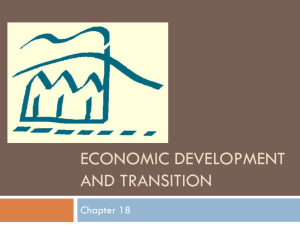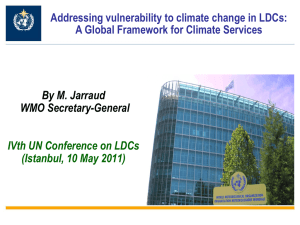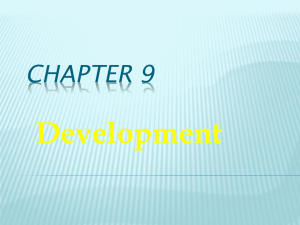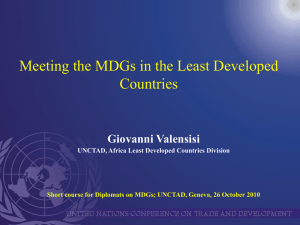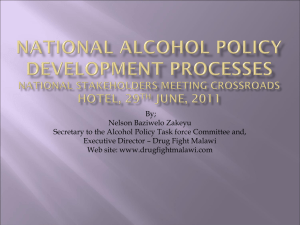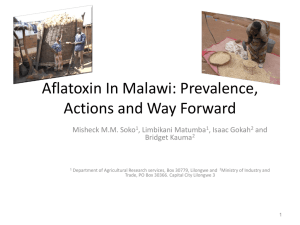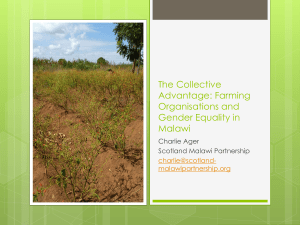ldc y13
advertisement
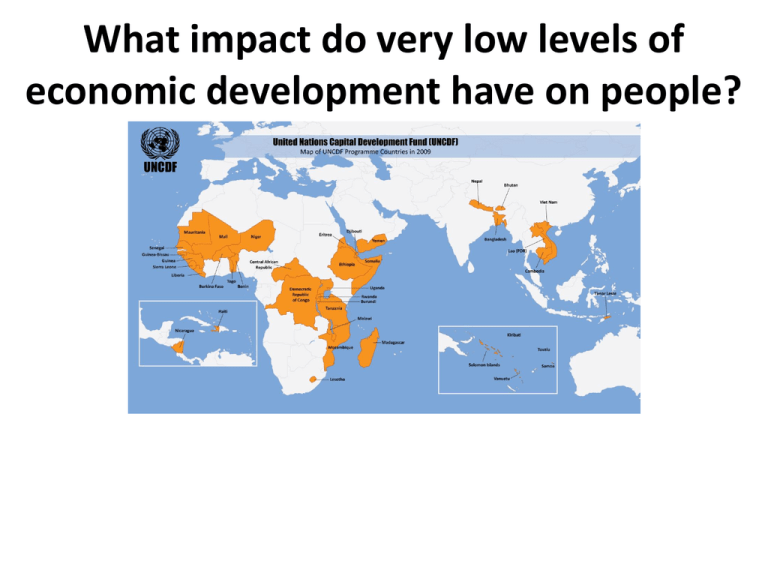
What impact do very low levels of economic development have on people? Objectives for the two lessons… • All will know the characteristics of the least economically developed countries and be aware of the impact of development on the lives of people in these countries. • Most will be able to exemplify these issues through a case study of (Malawi). • Some will use a range of sources to explore the extent to which the Millennium Development Goals are likely to be achieved in Malawi. • STRIPE: Reflective learner What are LDCs? • The Least Developed Countries represent the poorest and weakest segment of the international community. • The category of LDCs was officially established in 1971 by the UN General Assembly with a view to attracting special international support for this group of countries. • Four United Nations Conferences on the LDCs had been held since, each charting a decade programme for the LDCs. The first two were held in Paris in 1981 and in 1990, the third in Brussels in 2001 and the fourth in Istanbul in 2011. Who are the LDCs? Why them? • The criteria used to identify this group of countries: – GNI per capita under $900 – Human Asset Index (made up of the % of pop undernourished, death rate of children 5 yrs or under, secondary school enrolment rates and adult literacy rates). – Economic Vulnerability Index (extent to which a country would be affected by unplanned ‘shocks’. It is based on pop size, remoteness, imp of agriculture, risk of homelessness and dependence on exports) – A population of less than 75 million (NB: 1991) Characteristics of LDCs • Average income of less than $475 (£288) a person a year. • Weak human resources as measured by nutrition, infant mortality, secondary school environment and adult literacy. • High economic vulnerability as measured by factors such as population size, remoteness, share of agriculture, and homelessness due to natural disasters. • A country "graduates" from LDC status if the figure hits $900. Main challenges facing LDCs • High levels of poverty: more than half the 800 million people in the LDCs live on less than a dollar a day. Women in LDCs have a one in 16 chance of dying in childbirth, compared to one in 3,500 in North America. • Food insecurity: More than 300 million Africans are food insecure. • Economic vulnerability: LDCs are highly dependent on external sources of funding, including official development assistance, workers' remittances and foreign direct investment. This overly exposes them to external shocks such as the global financial crisis. • Environmental vulnerability: While they contribute least to climate change, LDCs are among the groups of countries most affected by it. Many LDCs are also small islands whose very survival is threatened by rising sea levels. What is being done to help LDCs? • The United Nations Conference on the LDCs closed in May 2011 in Istanbul, Turkey, put forward a number of recommendations seeking to halve, from 48 to 24, the number of LDCs during the next 10 years. • See details from: www.guardian.co.uk/globaldevelopment/povertymatters/2011/may/13/least-developedcountries-un-conference-action-plan Successes? • Since the establishment of the category in 1971, only three countries have "graduated" from the list: –Botswana in 1994, –Cape Verde in 2007 and –Maldives in January 2011. HIPCs • Highly Indebted Poor Countries (HIPCs) are the 38 least developed countries in the World (with the most poverty and debt) as identified by the IMF and World Bank (currently most of them are in sub-Saharan Africa). • In 1996, due to pressure from NGOs, HIPCs were identified in an attempt to reduce their debt burdens. • In 2005 during the G8 conference in Gleneagles, the World Bank, the IMF and the African Development Bank cancelled all loans (worth US$40 billion) owed to them by 18 HIPCs. The countries that qualified were: Benin, Bolivia, Burkino Faso, Ethiopia, Ghana, Guyana, Honduras, Madagascar, Mali, Mauritania, Mozambique, Nicaragua, Niger, Rwanda, Senegal, Tanzania, Uganda and Zambia HIPCs continued • To qualify for debt cancellation the countries had to: demonstrate good financial management and lack of government corruption. The money saved HAD to be spent on poverty reduction, education and health care. • By 2008, 27 of the 38 HIPCs had met the conditions for debt relief • However, African countries still owe US$300 billion, and due to civil war, several need to take out more loans, thus increasing this debt. • Debt campaigners believe that there are other countries that should be classed as HIPCs. Task 1 • Add notes to the diagram Reflection… • ‘All will know the characteristics of the least economically developed countries and be aware of the impact of development on the lives of people in these countries.’ • To what extent have you achieved this objective? • What do you need to do to build upon this? Task 2 • Look at statistics about Malawi • Watch the mini-movies about Malawi to find out more… • http://www.youtube.com/watch?v=NR0OHcY5 _4M • http://www.youtube.com/watch?v=Re1AMebt GvE Reflection… • Are these statistics as you expected? • Is anything surprising? • Why? Task 3 • “Countries at very low levels of economic development face such huge challenges that they cannot hope to address them without assistance from the rest of the world.” • To what extent do you agree with this view? • Prepare a short statement to answer this question in relation to Malawi – be ready to share this with the class. This was a 40 mark exam question – how well do you think you could answer it? Reflection… • ‘All will know the characteristics of the least economically developed countries and be aware of the impact of development on the lives of people in these countries. • Most will be able to exemplify these issues through a case study (of Malawi).’ • To what extent have you achieved your objectives? What do you need to do to build upon this? Extra reading… • www.guardian.co.uk/global-development/povertymatters/2011/may/13/least-developed-countries-unconference-action-plan • www.guardian.co.uk/global-development/povertymatters/2011/may/06/goal-halve-ldcs-10-years-conference • http://en.wikipedia.org/wiki/Heavily_Indebted_Poor_Countries • www.unohrlls.org/en/home/ • www.unohrlls.org/UserFiles/File/LDC%20Pocketbook2010%20final.pdf LDCs statistical pocket book. Homework • ‘What are the characteristics of the countries which make up the group known as least developed countries (countries at a low level of economic development).’ 8 marks. ‘What are the characteristics of the countries which make up the group known as least developed countries (countries at a low level of economic development).’ 8 marks. Mark your answer to this question using the mark scheme in your pack. Mark Scheme: • Level 1 Straightforward statements, very much a list of characteristics, e.g. low GNP, low literacy, low life expectancy, low levels of calorie intake, etc. (1–4 marks) • Level 2 Recognises that the characteristics can be placed into categories, such as economic, social, political. Links made between some of the problems listed above, such as lack of capital leading to poor education and health services giving low life expectancy and low levels of literacy. Puts in some detail such as figures, and may back up material with examples. (5–8 marks) • What have you done well? • What do you need to work on? Objectives for two lessons… • All will know the characteristics of the least economically developed countries and be aware of the impact of development on the lives of people in these countries. • Most will be able to exemplify these issues through a case study of Malawi. • Some will use a range of sources to explore the extent to which the Millennium Development Goals are likely to be achieved in Malawi. • STRIPE: Reflective learner Task 1 • Watch http://www.youtube.com/watch?v=ReRx12QUv54 to find out about the Millennium Development goals. Task 2 • Look at the different sources of data in your pack. Task 3 • To what extent do these sources suggest that Malawi will be successful in achieving the millennium development goals by 2015? Extension task • Either carry out your own research to develop a case study of another country with very low levels of development, or look at http://news.bbc.co.uk/1/hi/world/africa/8320 781.stm to find out more about the challenge of achieving the millennium development goals in Malawi. Reflection… • Share your answers to task 3 - do you agree on the extent to which the sources suggest that Malawi will achieve the millennium development goals? • How may your own values and attitudes influence your views? Reflection… • ‘Some will use a range of sources to explore the extent to which the Millennium Development Goals are likely to be achieved in Malawi.’ • ‘STRIPE: Reflective learner’ • To what extent have you achieved your objectives? What do you need to do to build upon this?

